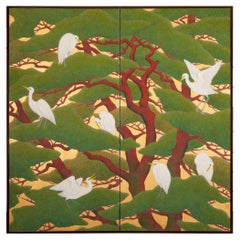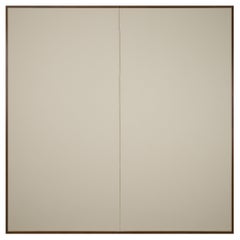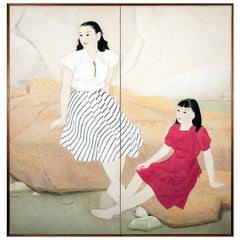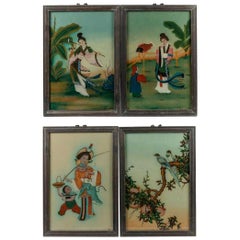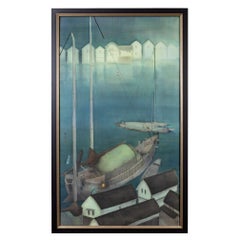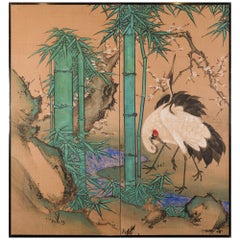Japanese Paintings
345
4
to
14
249
40
349
349
349
11
5
1
1
1
53
133
159
4
83
43
16
14
1
12
4
1
2
6
9
1
Height
to
Width
to
219
186
150
147
128
12,866
10,041
6,059
5,238
3,028
3
2
2
1
1
Place of Origin: Japanese
Japanese Two-Panel Screen: Egrets in Japanese Red Pine with Gold Ground
Located in Hudson, NY
Seven graceful Egrets perched upon very vibrant pine. Representing strength, luck, and longevity. A harmonious balance in nature. Mineral pigments on Mulberry paper with dark brown ...
Category
Late 19th Century Antique Japanese Paintings
Materials
Lacquer, Paper
Japanese Two Panel Screen Plain Mulberry Paper
Located in Hudson, NY
(no image) on lattice frame. Pair available; Sold seperately.
Category
Mid-20th Century Japanese Paintings
Materials
Paper
Japanese Two-Panel Screen "Women in Western Dress"
Located in Hudson, NY
Japanese Two Panel Screen: Women in Western Dress, Nihonga style painting of two young women in Western style summer clothing, sitting at water's edge and cooling off by putting their feet in the water. Showa period painting...
Category
1930s Showa Vintage Japanese Paintings
Materials
Wood, Paper
Set of Four Japanese Reverse Paintings
Located in Locust Valley, NY
Set of four Japanese reverse paintings.
Category
Early 20th Century Japanese Paintings
Materials
Glass
Framed Painting on Silk, Harbor at Night By: Chiga Saku
Located in Hudson, NY
Pigments on silk. Signature and seal read: Chiga saku (Acid free mounting with UV plexiglass) Painting dimentions: 59" H x 34" W, overall dimentions: 63 1/4" H x 38 1/2" W.
Category
Early 20th Century Japanese Paintings
Materials
Silk
Japanese Two Panel Screen Amorous Cranes and Turtles
Located in Hudson, NY
Japanese two panel screen: Amorous Cranes and Turtles. In Japan, cranes symbolize fidelity as they mate for life and turtles symbolize longevity. Additionally, this screen also has the Japanese motif of sho-chiku-bai, or the three friends of winter (pine, plum, and bamboo). So called the three friends of winter because all three flourish during the cold months. This screen was originally fusuma doors...
Category
1850s Edo Antique Japanese Paintings
Materials
Wood, Paper
Japanese Screen Painting, Circa 1700 'Tales of Ise' by Tosa Mitsusuke
By Tosa Mitsusuke 1
Located in Kyoto, JP
A six-fold Japanese screen by Tosa Mitsusuke (1675-1710), Japan 17th-18th century, Edo period.
The signature reads Shoroku-i ge Tosa sa Konoe Shogen Mit...
Category
Late 17th Century Edo Antique Japanese Paintings
Materials
Gold Leaf
Japanese Two-Panel Screen: Ink Landscape on Silk
By Shunyu
Located in Hudson, NY
Japanese Two Panel Screen: Ink Landscape on Silk, Meiji period (1868 - 1912) painting of a man riding a mule on a pathway through the Kurotani mountains with a thatched roof shelter ...
Category
19th Century Meiji Antique Japanese Paintings
Materials
Silk, Wood
Antique Japanese Hand-Painted Village Landscape Scene on Paper in Custom Frame
Located in Yonkers, NY
A large antique Japanese hand-painted village landscape scene set in custom frame under glass. This large antique Japanese village landscape painting captures the tranquil beauty of ...
Category
Early 20th Century Japanese Paintings
Materials
Composition
Early 20th Century Japanese Screen Pair - Ink Pine Trees on Gold
Located in Kyoto, JP
Imao Keisho (1902-1993)
Pine Trees
Early 20th Century, Circa 1930
Pair of six-panel Japanese screens. Ink on silk and gold leaf.
Dimensions: Each screen H. 67.5” x 148” (172 cm x 376 cm)
A pair of monumental six-panel Japanese pine screens by the renowned Nihonga artist Imao Keisho. Here Keisho entirely removed the background and brought the pine trees to the surface of the painting. This simplification of the elements makes the scene exceptionally direct and compelling and injects a very modern...
Category
Early 20th Century Showa Japanese Paintings
Materials
Gold Leaf
Antique Japanese Ink Hanging Scroll Nakabayashi Chikuto Edo Period
By Hidaka Tetsuo
Located in Atlanta, GA
An ink painting on paper (Sumi-e) mounted with brocade borders as a hanging scroll. Entitled "Plum Blossom Under a Misty Moon", the artist was Japanese painter Nakabayashi Chikuto (1...
Category
19th Century Japonisme Antique Japanese Paintings
Materials
Brocade, Wood, Paper
Contemporary Abstract Oriental Signed Painting
By Kozo Inoue
Located in Roma, IT
Wonderful contemporary abstract Kozo Inoue signed painting
Series of 4 canvas assembled to form a single painting signed Kozo Inoue dated 1974
This painting, never before on the mark...
Category
Mid-20th Century Mid-Century Modern Japanese Paintings
Materials
Canvas
Japanese Screen, 19th Century, Rabbits and Horsetail Reeds on Silver Leaf
By Nenma
Located in Kyoto, JP
Unknown artist
Rabbits and Horsetail Reeds
Painted in the Year of the Fire Dog, 1826 or 1886. 19th century.
The scene depicted here is set under moonlight, with two hares hi...
Category
Mid-19th Century Edo Antique Japanese Paintings
Materials
Silver Leaf
Small Wall Hanging Art / Japanese paper / Sand paint / Ink
Located in Iwate-gun Shizukuishi-cho, Iwate Prefecture
This is a small wall hanging picture.
Japanese paper is pasted and colored on wooden panels.
In addition, sand-like paint is layered and partially colored with ink.
The boundary o...
Category
21st Century and Contemporary Japanese Paintings
Materials
Sandstone
An Original Mitsuaki Sora Woodblock Print Titled "PEACE" in frame
Located in Los Angeles, CA
Mitsuaki Sora is a well-known stone sculptor who also makes woodblock prints. In the late 1960s, his prints were of very colorful abstract shapes, such a...
Category
1970s Minimalist Vintage Japanese Paintings
Materials
Canvas, Glass, Paint
Japanese Four Panel Screen: Herons on Snow Laden Branch
Located in Hudson, NY
Ink and slight color on silk in free standing wood frame. Signature reads: Takeuchi Seiho.
Category
Late 19th Century Antique Japanese Paintings
Materials
Silk, Paper, Wood
Ohashi Suiseki, Resting tiger, Japanese watercolor on silk, Japan circa 1900
Located in PARIS, FR
Ohashi Suiseki, Resting tiger, watercolor on silk, circa 1900
Midori Ohashi (Ohashi Suiseki, April 1865 -August 31, 1945 ) is a Japanese painter who was...
Category
Late 19th Century Antique Japanese Paintings
Materials
Silk
Japanese Painting on Fabric
Located in New York, NY
It was love at first sight for us with this stunning Japanese pastoral scene on fabric. Beautifully painting with soft, muted colors, the piece captures a lovely moment in the mounta...
Category
20th Century Japanese Paintings
Materials
Fabric
A workbench used by a lacquer craftsman/Before 1972/Like an abstract painting
Located in Sammu-shi, Chiba
We have a unique Japanese aesthetic sense.
And only we can introduce unique items through our purchasing channels in Japan and the experience we have gained so far, in such a way tha...
Category
Late 20th Century Showa Japanese Paintings
Materials
Pine
Pair of Japanese Edo Rimpa School Screens after Tawaraya Sotatsu
Located in Rio Vista, CA
Impressive pair of 17th century Japanese Edo period Rinpa school screens made in the manner and style of Autumn Grasses by Tawaraya Sotatsu (1570-1640). Beautifully decorated with wi...
Category
17th Century Edo Antique Japanese Paintings
Materials
Gold Leaf
Japanese Folding Screen Six Panels Painted on Gold Leaf
By Japanese Studio
Located in Brescia, IT
Paravento a sei pannelli di scuola giapponese Kano: paesaggio con bellissime ed eleganti gru vicino al fiume, con alberi di pino e sakura.
Dipinto a mano con pigmenti minerali ed inc...
Category
Early 19th Century Edo Antique Japanese Paintings
Materials
Gold Leaf
Japanese Antique Folding Screen "雨路風 " 1974 /Mingei Wabisabi/
Located in Sammu-shi, Chiba
If you want something special, we recommend purchasing items selected by BROOD.
We sell carefully selected old Japanese items.
I've seen tens of thousands of items so far.
Based on t...
Category
1970s Showa Vintage Japanese Paintings
Materials
Paper
Japanese Miniature Four-Panel Screen Blue and Green Landscape
Located in Rio Vista, CA
19th century mid-Edo period Japanese four-panel miniature screen. Depicting a beautifully painted Chinese blue and green landscape in the Nanga School...
Category
19th Century Edo Antique Japanese Paintings
Materials
Brass
Monumental Antique Mounted Japanese Daimyo Procession Hand Scrolls, Set of Four
Located in Sheridan, CO
Very unique and rare museum quality professionally framed Japanese Daimyo procession hand scroll, likely Meiji Period (1868-1911). The set of 4 scrolls feature ink and color figural ...
Category
Late 19th Century Meiji Antique Japanese Paintings
Materials
Acrylic, Hardwood, Paint, Paper
Antique Japanese Blockprint Painting Japan Edo or Meiji
Located in Amsterdam, Noord Holland
Antique Japanese Blockprint Painting Japan Edo or Meiji.
A very nice blockprint.
Additional information:
Type: Paintings, Scrolls & Prints
Region of Origin: Japan
Country of Manufa...
Category
19th Century Antique Japanese Paintings
Antique Student Writing Map Japanese Lacquer Ware Writing Meiji Period
Located in Amsterdam, Noord Holland
Antique Student Writing Map Japanese Lacquer Ware Writing Meiji Period Japan
Some damage
Additional information:
Material: Lacquer
Region of Origin: Japan...
Category
19th Century Antique Japanese Paintings
Materials
Lacquer
Yoshio Minomura Signed Abstract Oil and Ink on Canvas Painting
Located in Indianapolis, IN
An oil on canvas painting by the Japanese artist Yoshio Minomura (born 1947). This abstract work depicts a patchwork of colors in white, black, orange, yellow, green and blue. Sectio...
Category
20th Century Modern Japanese Paintings
Materials
Canvas, Paint
Japanese Mid-Size 6-Panel Byôbu 屏風 Screen with Chicken Family in a Flower Field
Located in Amsterdam, NL
A charming medium-size six-panel byôbu (folding screen) with a vibrant polychrome painting of a rooster with its family amidst a luscious flower garden.
The garden is filled with al...
Category
Early 20th Century Japanese Paintings
Materials
Silk, Lacquer, Paper
Lovely Japanese Painting ‘Woman in Sitting Position’ Antique Meiji, ca 1900
Located in Amsterdam, Noord Holland
Interesting and finely painted Japanes painting. Marked.
Additional information:
Material: Paper
Type: Paintings, Scrolls & Prints
Region of Origin: Japan
Period: ca 1900
Age: ca 19...
Category
19th Century Antique Japanese Paintings
Materials
Paper
Antique Chinese or Japanese Fish Painting China Japan Qing / Edo or Meiji
Located in Amsterdam, Noord Holland
Antique Chinese or Japanese Fish Painting China Japan Qing / Edo or Meiji.
A very nice painting.
Additional information:
Type: Paintings, Scro...
Category
19th Century Antique Japanese Paintings
Materials
Paper
Antique Hiroshige Tokaido Road 29th station : Hamamatsu : Japanese Blockprint
Located in Amsterdam, Noord Holland
Antique Japanese Blockprint Painting Japan Edo or Meiji.
A very nice blockprint.
Additional information:
Type: Paintings, Scrolls & Prints
Region of Origin: Japan
Country of Manufa...
Category
19th Century Antique Japanese Paintings
Materials
Agate
Antique Japanese Painting Japan Meiji Period Dear in Winter
Located in Amsterdam, Noord Holland
Antique Japanese Painting Japan Meiji Period Dear in Winter.
A very nice blockprint.
Additional information:
Type: Paintings, Scrolls & Pri...
Category
19th Century Antique Japanese Paintings
Japanese Showa Six Panel Screen Manchurian Crane Bamboo Grove
Located in Rio Vista, CA
Enchanting Japanese Showa period six-panel byobu screen titled "Bamboo Forest-Immortal Together". The large screen depicts six manchurian cranes in a ...
Category
20th Century Showa Japanese Paintings
Materials
Brass
JOICHI HOSHI (1911-1979), Blue Tree, Woodblock, signed lower right, Dated 1973
Located in Melbourne, Victoria
Joichi Hoshi Blue Tree Top woodblock with gold pigment. This is a fine example of the artists genre.
Joichi Hoshi was born in Niigata, Japan in 1913. He worked as a teacher in Tai...
Category
1970s Vintage Japanese Paintings
Materials
Paper
Kiyoshi Ishii Abstract Oil on Canvas, Japan c1984
Located in Oakland, CA
Fantastic abstract oil on canvas with a wonderful color palette by famous Japanese artist, Kiyoshi Ishii, born in Kanagawa prefecture in 1941. In 1963 he...
Category
1980s Modern Vintage Japanese Paintings
Materials
Canvas, Wood, Paint
Japanese 2-Panel Furosaki’byôbu 風炉先屏風 'Tea-Ceremony Folding Screen' with Dragons
Located in Amsterdam, NL
A striking low and wide two-panel furosaki’byôbu (tea-ceremony room divider) painted with two bright white dragons (ryû) flying amidst swirling black clouds. The left dragon holds a ...
Category
Early 20th Century Japanese Paintings
Materials
Wood, Paper
19th Century Japanese Screen Pair. Flowers & Birds of the Four Seasons
Located in Kyoto, JP
Flowers & Birds of the Four Seasons
Pair of six-fold Japanese Screens. Ink, color, gofun and gold on paper.
Second half of the 19th Centur...
Category
Late 19th Century Meiji Antique Japanese Paintings
Materials
Wood, Paper
Japanese Screen Painting, circa 1700 'Horses' by Kano Tanshin
Located in Kyoto, JP
Horses
Kano Tanshin Morimasa (1653-1718)
Two-panel tea-ceremony Japanese screen or furosaki
Ink on gold leaf,
late 17th-early 18th century
Measures: H 55 cm x W 182 cm
The Kano school was closely aligned with the warrior class in Japan. The samurai, who lived in a closed and rigid hierarchical society established by the Shogunate, were drawn to the energy and freedom horses symbolize; Kano school artists commonly depicted the equine creatures as they are here, in unfettered and carefree family groups. China originally introduced horse paintings to Japan; the works typically focused on capturing the essence of horses in their various environments and often involved integrating human figures into the images.
Kano Tanshin Morimasa (1653-1718) was the son of Kano Tanyu...
Category
1690s Edo Antique Japanese Paintings
Materials
Gold Leaf
Mid-18th Century Japanese Screen Pair, One Hundred Flowers, Chrysanthemums
Located in Kyoto, JP
Omori Soun (b. 1704)
Chrysanthemums - One Hundred Flowers
A Pair of Six-fold Japanese Screens. Ink, color, gofun and gold leaf on paper.
Dating ...
Category
Mid-18th Century Edo Antique Japanese Paintings
Materials
Gold Leaf
Set of 6 Large Kakemonos Japanese Mythology, 19th Century Japan circa 1800 Edo
Located in Beuzevillette, FR
Beautiful set of 6 large kakemonos from 19th century Japanese mythology.
Paper support with a canvas pasted on the paper
Wonderful set that is part of Japan's history and beliefs
When not hung, the Kakemonos are rolled up.
circa 1800 - Japan - Edo Period
A kakemono translates as "object to hang". In Japan this refers to a painting or calligraphy, most often done on silk or paper framed in a scroll that was intended to be hung on walls or in public lighting. This particular form, which allows them to be in a roll, dates back to the Tang dynasty in China (this would be related to the copying and preservation of ancient Buddhist texts). A Kami is a deity or spirit worshipped in the Shinto religion. A Yokai is a spirit, ghost, demon, or strange apparition from the creatures of Japanese folklore.
Each of these kakemonos represents a unique story:
- A kami, a Japanese deity, is shown painting a rainbow. Indeed, he performs the action with his right hand while his left hand holds a kind of basket with three pots of paint. This kami has a rather closed attitude. He is standing in a dark and tormented sky. Below this figure, 8 villagers are dressed in traditional Japanese clothes. Their faces are softened. They are not afraid of the elements made by the kami above their heads.
- A character with an unreal look is holding a kind of jar with his two hands, which he spills on human figures above. This being is floating in the air, probably a character from mythology, perhaps Susanoo. Underneath, villagers on umbrellas. They are trying to protect themselves as best they can from what is falling on them. One of them is carrying baskets with fish on her shoulders. A character in the background is thrown forward and falls.
- On this kakemono, the god Raijin, dressed in a white and blue outfit, strikes the sky with his two drum hammers to create lightning and its thunderous sound. Surrounded by Tomoe and a long red scarf, Raijin, enraged and with dishevelled hair, creates a dark and violent storm. The villagers seem frightened by this meteorological phenomenon. One of the villagers can be seen fainting in the arms of a man. This scene may seem chaotic, but Japanese legend tells us that once a field is struck by lightning, the harvest is good.
- On this kakemono, we see an unreal-looking figure holding a fan, as if he were sweeping away the bad weather, or simply producing gusts of wind. He is probably the kami of wind and air, Shina tsu-hiko. The figures below him seem surprised by so much wind. An umbrella flies away on the left, the women hold their hair and scarf, the clothes are caught in the power of the wind, there is even a woman on the ground on the bottom left.
- This Kakemono represents a short moment. This Raiju is a yokai (ghost spirit...
Category
19th Century Edo Antique Japanese Paintings
Materials
Paper
Set of Three Japanese Watercolors in the Manner of Hanabusa Itcho
Located in Bradenton, FL
Manner of ITCHO, Hanabusa, (Japanese, 1652-1724): Three watercolor and ink drawings on paper, to include:
1) Man seated with monkey , signed right side, 16.25" x 11.25".
2) Man sta...
Category
19th Century Anglo-Japanese Antique Japanese Paintings
Materials
Paint, Paper
Pair of Early 20th Century Japanese Costume Portraits Painted on Silk
Located in London, GB
Two portraits of Japanese man and women in traditional costume painted on silk, circa 1920, in their original frames. Details show the exquisite tradit...
Category
1920s Art Deco Vintage Japanese Paintings
Materials
Wood
Japanese Painting, Hanging Scroll, 19th Century Bamboo in Moonlight
Located in Kyoto, JP
Bamboo in moonlight
Gamo Rakan (1784-1866)
Hanging scroll, ink on silk.
Dimensions:
Scroll: 201 cm x 58 cm
Image: 137 cm x 45 cm
In this early 19th century work by Gamo Rakan a light ink wash applied to the silk background silhouettes the moon and suggests the atmosphere of early evening. Even though it is a literati subject, Rakan’s bamboo is quite realistic with a strong decorative style. The painting finds its inspiration from Chinese Ming dynasty painters who often used a single-tone, jet black stroke to emphasize the calligraphic nature of bamboo.
In a different era, decorative would have been seen as somewhat unrefined. But increasingly in the Edo period, it was the hallmark of high style. The Japanese people, in particular the rising merchant class, had gradually become apathetic toward the traditional Sesshu and Kano schools of painting. Chinese professional and amateur painters living in the port of Nagasaki during the 18th century had a profound effect on Japanese painting and the freshness of their style and its decorative appeal contributed greatly to its popularity. Gamo Rakan’s teacher, Tani Buncho...
Category
Early 19th Century Edo Antique Japanese Paintings
Materials
Silk
Early 19th Century Japanese Screen. Cherry Blossom & Pheasants by Mori Tetsuzan
Located in Kyoto, JP
Mori Tetsuzan (1775-1841)
Pheasants and Cherry Blossoms
Two-fold Japanese screen. Ink, color, gofun, gold and silver on paper.
A two-fold Japanese bir...
Category
Early 19th Century Edo Antique Japanese Paintings
Materials
Gold Leaf
Framed Japanese Painting on Silk, Court Figures in a Garden Landscape
Located in Hudson, NY
Beautifully painted in detail. Soft, elegant style of painting. Acid free mounting with UV plexiglass.
Category
Late 19th Century Antique Japanese Paintings
Materials
Silk
Japanese Silk Suijaku Scroll Nyorai-Kojin with Mixed Buddhism and Shinto Deities
Located in Atlanta, GA
A Japanese silk Suijaku hanging scroll beautifully presented in a custom wood shadow box frame from Edo period (circa 18-19th century). The scroll, surmounted on golden brocade was painted in fine details with gouache, ink and gold powder highlight, served as a Suijaku mandala for the worshippers. Honji Suijaku is a complicated religious concept uniquely developed in Japan. It mixed and hybrid the Buddism deities with native shinto spirits (known as Kami), which were seen as local manifestations (the suijaku, literally means a "trace") of Buddhist deities (the honji literally the original ground). The original idea may lie with the synergetic strategy to spread Buddism by making it more relatable to the local population who had already worshiped Shinto gods. The paradigm, adopted in the 10th century from an orignal Chinese concept, remained a defining feature of Japanese religious life up to the end of the Edo period (1868). Instead of being confined to deities, its application was often extended to historical figures as shown on this scroll.
This long hanging scroll depicts an arrangement of 21 figures including Buddhism and Shinto deities as well as two historical figures on the bottom. Each figure was name-tagged in Kanji for easy identification by the worshippers. It was used in the temple or shrine so that when the worshipper prayed in front the mandala, they prayed simultaneously to all the deities.
On the very top, sits Nyorai-Kojin, a hybrid deity of Nyorai Buddha and Kojin, the kaki for fire, stove and kitchen. From the top to bottom and left to right, here is the list of the deities: Kanon with Thousand Hands, Kanon with Willow Branch, Monju Bosatsu...
Category
Early 19th Century Edo Antique Japanese Paintings
Materials
Silk, Wood
Vintage Japanese Abstract Oil on Canvas Yoshi c1979
Located in Oakland, CA
Handsome vintage abstract oil on canvas by unknown Japanese artist, signed "Yoshi 1979". Excellent use of color and texture, mounted in ...
Category
1970s Modern Vintage Japanese Paintings
Materials
Wood, Paint
Large Lithograph of a Japanese Scene After the Tale of Genji
Located in Pasadena, CA
This lithograph is an illustration of the classic Japanese novel, "The Tale of Genji," written by Murasaki Shikibu. It captures the aristocratic atmo...
Category
19th Century Han Antique Japanese Paintings
Materials
Paper
Japanese Two-Panel Screen Temples Through Misty Forest
Located in Hudson, NY
Japanese two-panel screen: Temples Through Misty Forest. Chinese School landscape ink painting on gilded silk by Yukimatsu Shunpo, signed and dated 1924. Yukimatsu Shunpo was born in...
Category
1920s Taisho Vintage Japanese Paintings
Materials
Wood, Silk
Vintage Japanese Watercolor Painting of Two Geisha, Signed, Late 20th Century
Located in Chatham, ON
Vintage watercolor painting of two Geisha under an umbrella - watercolor over graphite with gold gilt border - signed upper right (unidentified artist/maker...
Category
Late 20th Century Japonisme Japanese Paintings
Materials
Paint, Paper
Lake Side: Copy of Kuroda Seiko's Painting, Painting, Oil on Canvas
Located in Fukuoka, JP
Introducing a remarkable oil painting on linen canvas, meticulously reproduced to capture the essence of the renowned work by Kuroda Seiki. The original masterpiece, titled "Lake Sid...
Category
20th Century Japanese Paintings
Materials
Canvas, Linen, Wood
Japanese Six-Panel Screen Garden Landscape by River's Edge
Located in Hudson, NY
Kano School painting showing ancient pine, exotic birds, peonies, azalea and cherry tree in bloom on far right. Early Edo period painting, (1614 -...
Category
Late 17th Century Edo Antique Japanese Paintings
Materials
Gold Leaf
19th Century Japanese Framed Hand-Painted on Silk
Located in Marbella, ES
19th century Japanese framed hand painted on Silk.
Category
19th Century Antique Japanese Paintings
Materials
Silk, Wood
Japanese Two Panel Screen: Pomegranate Tree
Located in Hudson, NY
With various flowers, manderin ducks and garden stone accented with gold leaf on ground surface. Nagasaki School Painting.
Category
Mid-19th Century Antique Japanese Paintings
Materials
Silver Leaf
Japanese Two Panel Screen, Chrysanthemums
Located in Hudson, NY
Beautiful white chrysanthemums are emphasized by heavy gold on a soft floral landscape, while gold clouds create a striking and dream-like floral scene. Gold leaf and gofun with min...
Category
Early 18th Century Antique Japanese Paintings
Materials
Gold, Gold Leaf
Early 20th Century Japanese Cherry Blossom Screen by Kano Sanrakuki
Located in Kyoto, JP
Cherry Blossoms
Kano Sanrakuki (1898-1981)
Showa period, circa 1930
2-panel Japanese Screen
Color, gofun and gold leaf on paper
Against a backdrop of gold-leafed ground, the lichen covered trunk and branches of the life-sized cherry blossom tree reach out and beyond the confines of the pictorial surface. The overall composition has a feeling of flatness which draws emphasis to the surface and the three-dimensionality of the cherry blossoms. Painstakingly built-up layers of thickly applied shell-white gofun detail the voluminous blossoms and cover large areas of this tour-de-force of Japanese Nihonga painting. By simplifying the background, minimizing the number of colors and depicting the blossoms with such heavy relief, the artist has emphasized the stunning presence of the cherry tree. The type of tree depicted is the Yae-Zakura; a double-layered type of cherry blossom famed for its beauty and strength. When we think of Japanese cherry blossoms, the first thing that comes to mind is Somei Yoshino variety, which has a single flower with five almost white petals. This type is fragile and easily blown away by strong wind or rain. Most of the double-flowered cherry blossoms begin to bloom when the Somei-Yoshino falls, and the flowering period lasts longer than that of the Somei-Yoshino.
Kano Sanrakuki originally studied painting at the Kyoto City Arts and Crafts School under the tutelage of Yamamoto Shunkyo...
Category
Early 20th Century Showa Japanese Paintings
Materials
Gold Leaf
Japanese Six Panel Screen Scattered Fans
Located in Hudson, NY
Striking painting depicting scattered fans painted on gold leaf. Featuring various scenes from classic Japanese literature, flowers and birds. Mineral pigmen...
Category
Mid-18th Century Antique Japanese Paintings
Materials
Gold Leaf
Meiji Period Japanese Screen Pair, One Hundred Birds by Hasegawa Gyokujun
Located in Kyoto, JP
One hundred birds
Hasegawa Gyokujun (1863-1921)
Meiji period, circa 1900.
Ink, color and gofun on silk.
Dimensions of each screen:
H. 170 cm x W. 190 cm (67’’ x 75”)
Despite the title, well over 100 birds are represented in this pair of two-fold Japanese screens (the title functions figuratively to convey the idea of a large number). The monumental work is rendered with a comprehensive and highly complex composition which is exquisitely executed and meticulously colored. More a celebration of naturalism than the traditional “One Hundred Birds” paintings which originated in China. This was a subject matter known for its auspicious meaning as much as its actual depiction of nature. These paintings generally had a phoenix (occasionally peacocks) placed in the center, and the other birds paying homage to it.
In this quintessentially Japanese scene painted by Gyokujun, a couple of long-tailed birds modeled after paradise flycatchers are included; these are traditional auspicious motifs in Oriental bird and flower painting and denote themes such as celebration and enduring generations. In addition there is the playful inclusion of single exotic parrot. Even so, the vast majority of the birds and flowers are native to Japan. Reading the scene from right to left, from spring through to autumn, the overwhelming sense is one of movement and haste. It is almost as if the birds are in a race, with the fleetest leading the way forward. Although these native birds were commonly drawn amongst artists of the Shijo school, rarely were they painted with such drama and dynamism. It is not strictly a depiction of sketched birds whose manner was faithfully handed down through the traditions of the Shijo school. Rather we see Gyokujun seeking and achieving new expressions in the heart of the turbulent Meiji period.
Hasegawa Gyokujun (1863-1921) was born in Kyoto. He was the eldest son of Hasegawa Gyokuho, a Shijo school painter who studied under Matsumura Keibun. Gyokujun studied painting under his father and became a prominent member of the Kyoto painti
ng world from a young age. In 1891 he established the ‘Young Painters Social Club’ along with Takeuchi Seiho, Miyake Gogyo and Taniguchi Kokyo. Also in 1891 he was selected as a judge of the Great Private Paintings Exhibition along with Takeuchi Seiho, Yamamoto Shunkyo...
Category
Early 1900s Meiji Antique Japanese Paintings
Materials
Silk, Wood
Recently Viewed
View AllMore Ways To Browse
Long Buffet Vintage
Italian Dresser Brass
Modern Marble Console Base
Louis Xv Bureau Plat
Small Antique China Cabinet
Small Antique Chinese Cabinet
Small China Cabinet Antique
Console Table With Lions
Used Kitchen Cabinets And Counters
Antique Small China Cabinet
Antique Chinese Small Cabinet
Pair Of Swedish Commodes
Narrow Depth Storage
Store Display Case Wood
Traditional Wood Console Table
Matching Walnut Dressers
Sculptural Chest Of Drawers
Thick Glass Top Console Table
